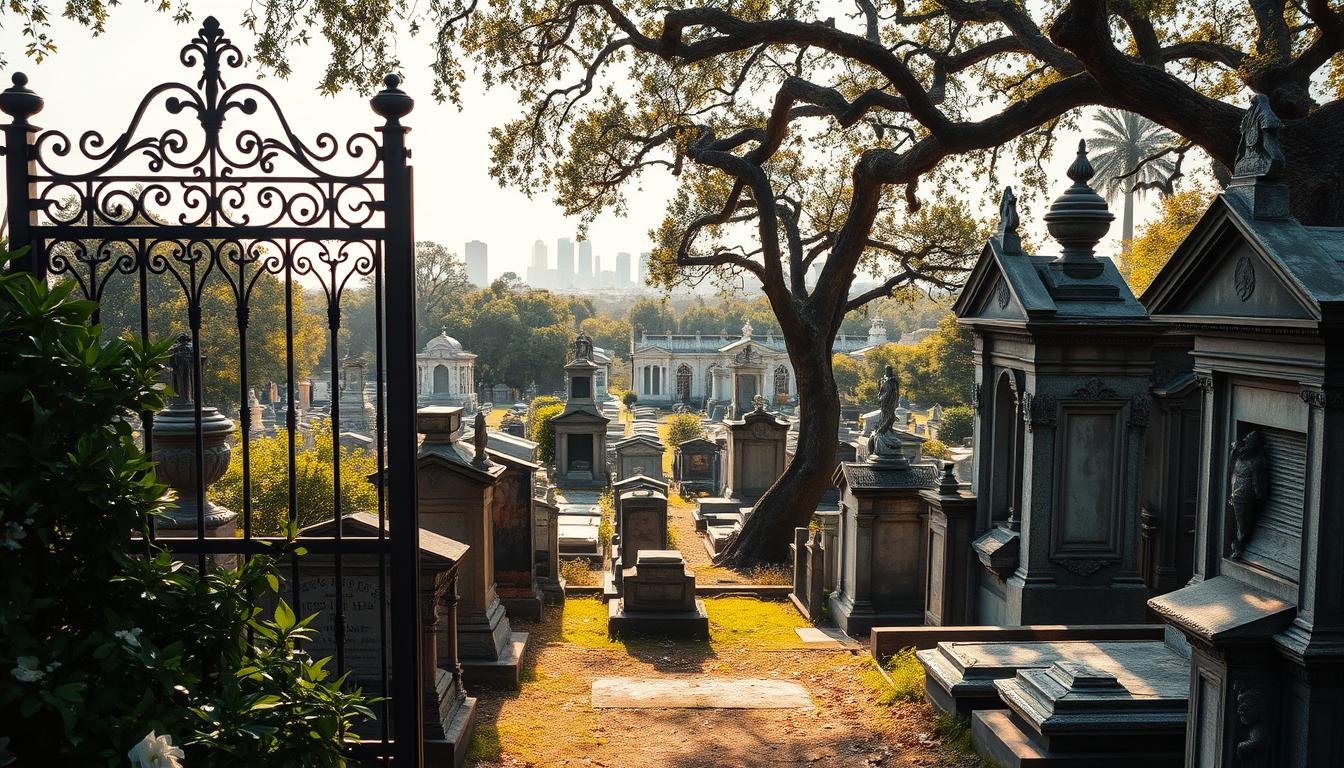As a local, I’m excited to take you on a journey through the historic cemeteries that make New Orleans so unique. These aren’t just final resting places – they’re vibrant cultural landmarks that tell the story of our city’s rich history and heritage.
From above-ground tombs to intricate stone carvings, every detail is a testament to the city’s blend of traditions and influences. As we explore these must-visit cemeteries, you’ll discover the significance of these sites, their architectural styles, and the legends that surround them.
Key Takeaways
- Discover the historical significance of New Orleans’ cemeteries
- Explore the unique architectural styles found in these cemeteries
- Uncover the legends and stories behind the tombs and graves
- Learn about the cultural influences that shaped these historic sites
- Get insider tips on the must-visit cemeteries in the Big Easy
Introduction to New Orleans Cemeteries
With their elaborate above-ground tombs, New Orleans cemeteries are a unique blend of history, culture, and architecture. As you walk through these historic sites, you’re not just visiting the resting places of the deceased; you’re stepping into a world that reflects the city’s complex heritage.
The city’s low elevation and high water table made it necessary to build tombs above ground, resulting in the iconic “cities of the dead” that New Orleans is known for. This unique necessity has evolved into a cultural and architectural phenomenon, making New Orleans one of the top burial grounds in New Orleans that attract visitors from around the world.
The Historical Significance of Cemeteries
New Orleans cemeteries are more than just burial grounds; they’re historical repositories that tell the story of the city’s past. From the grand tombs of St. Louis Cemetery No. 1 to the picturesque Lafayette Cemetery No. 1, each cemetery has its own story to tell about the people who lived and died in New Orleans.
As preservationist and historian, Sally Reeves, once said, “New Orleans cemeteries are the outdoor museums of the city, reflecting its history, culture, and traditions.” This quote encapsulates the essence of why these cemeteries are so significant, not just as places of mourning, but as vibrant cultural landscapes.
“The cemeteries of New Orleans are a microcosm of the city’s history, with tombstones and mausoleums that reflect the social, cultural, and economic fabric of the community.”
Unique Burial Practices in New Orleans
The burial practices in New Orleans are as unique as the city itself, influenced by its cultural melting pot. The use of above-ground tombs, for instance, is a practice that was adopted due to the city’s geographical challenges. Over time, this necessity evolved into an art form, with intricate stone carvings, ornate ironwork, and elaborate mausoleums becoming hallmarks of the city’s historic above-ground tombs.
The influence of various cultures, including African, European, and Caribbean traditions, is evident in the burial practices and tomb designs. This blend of cultures has resulted in a distinctive New Orleans identity, visible in the architecture and rituals associated with its cemeteries.
The Architecture of Famous Cemeteries
The architecture in New Orleans’ cemeteries is a unique blend of styles, influenced by the various cultures that have shaped the city. As you walk through these historic sites, you’ll notice the grand mausoleums, intricate tombs, and simple tombstones, each telling a story of the people who built them and those who rest within.
Styles of Tombs and Vaults
New Orleans is famous for its above-ground tombs, a necessity due to the city’s low elevation and high water table. These tombs range from simple family vaults to elaborate mausoleums that reflect the social status and cultural background of the deceased.
The styles of tombs and vaults vary significantly, from the neoclassical and Gothic Revival to the more modest, family-owned structures. Many of these tombs are adorned with statues, intricate carvings, and other ornaments that add to their beauty and historical significance.
| Tomb Style | Description | Cultural Influence |
|---|---|---|
| Neoclassical | Characterized by grand columns and classical motifs | European, particularly French and Italian |
| Gothic Revival | Features pointed arches, ribbed vaults, and intricate stone carvings | European, with a focus on medieval styles |
| Family Vaults | Simple, above-ground structures for family burials | Local tradition, influenced by various cultures |
Influences from Different Cultures
The cultural diversity of New Orleans is reflected in the architecture of its cemeteries. European, African, and Caribbean influences have all played a role in shaping the styles and traditions seen in these famous resting places in New Orleans.
For instance, the use of above-ground tombs is partly due to the city’s French and Spanish heritage, where such burial practices were common. African influences can be seen in the decorative elements and rituals associated with death and mourning.
Visiting these haunted graveyards in Louisiana offers a glimpse into the city’s rich cultural tapestry. Each tomb, vault, and mausoleum tells a story of the people who came before, their beliefs, and their traditions.
St. Louis Cemetery No. 1: A Must-Visit
Established in 1789, St. Louis Cemetery No. 1 is not only one of the oldest cemeteries in New Orleans but also a significant historical landmark. As you step through its gates, you’re immediately immersed in a world of above-ground tombs, intricate stone carvings, and the stories of those who rest here.
Notable Residents and Their Stories
One of the most famous residents of St. Louis Cemetery No. 1 is Marie Laveau, the Voodoo Queen of New Orleans. Her tomb is a place of pilgrimage for many, with visitors leaving offerings of flowers, coins, and other tokens of respect. Laveau’s legacy is complex, with stories of her powers and influence still captivating the imagination of visitors today.
Other notable residents include Bernard de Marigny, a wealthy Creole society figure who introduced the game of craps to the United States, and Delphine LaLaurie, whose gruesome history has become a part of New Orleans’ dark folklore. The stories of these individuals add depth and intrigue to the cemetery, making it a fascinating place to explore.
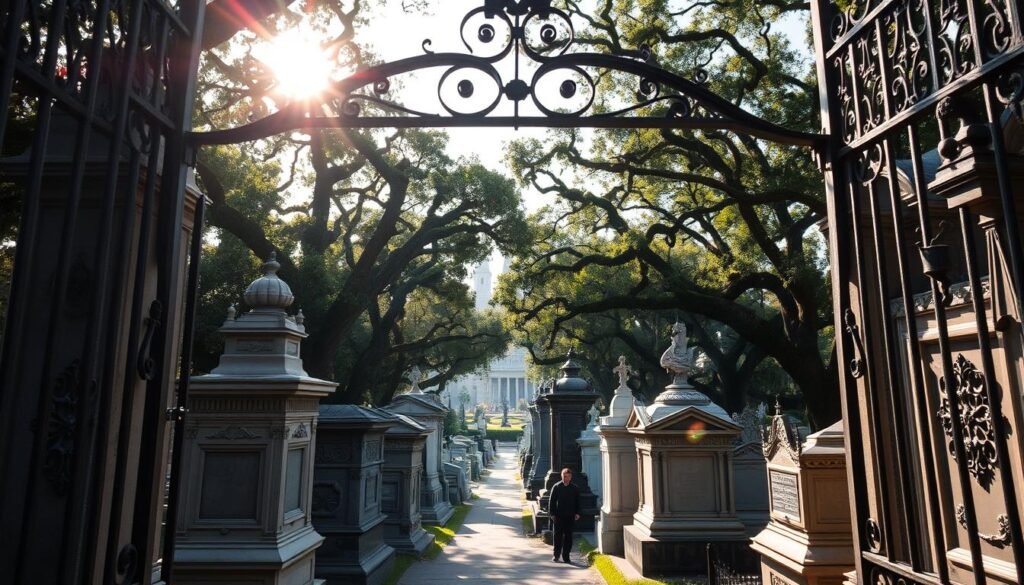
Visiting Information and Tips
Visiting St. Louis Cemetery No. 1 requires some planning. Due to its historical significance and the fragile nature of the tombs, visitors are required to take a guided tour. These tours not only provide access to the cemetery but also offer insights into its history, the stories of its residents, and the cultural significance of this sacred place.
- Book your tour in advance to ensure availability.
- Be respectful of the site and its residents; avoid touching or damaging the tombs.
- Wear comfortable shoes, as you’ll be doing some walking.
- Bring water and sun protection, as the Louisiana sun can be unforgiving.
By following these tips, you can ensure a meaningful and memorable visit to St. Louis Cemetery No. 1, allowing you to connect with the history and culture of New Orleans in a profound way.
Lafayette Cemetery No. 1: A Gem in the Garden District
As one of the top burial grounds in New Orleans, Lafayette Cemetery No. 1 is renowned for its historic above-ground tombs and tranquil atmosphere. Located in the heart of the Garden District, this cemetery is a must-visit destination for anyone fascinated by history, architecture, and the unique cultural heritage of New Orleans.
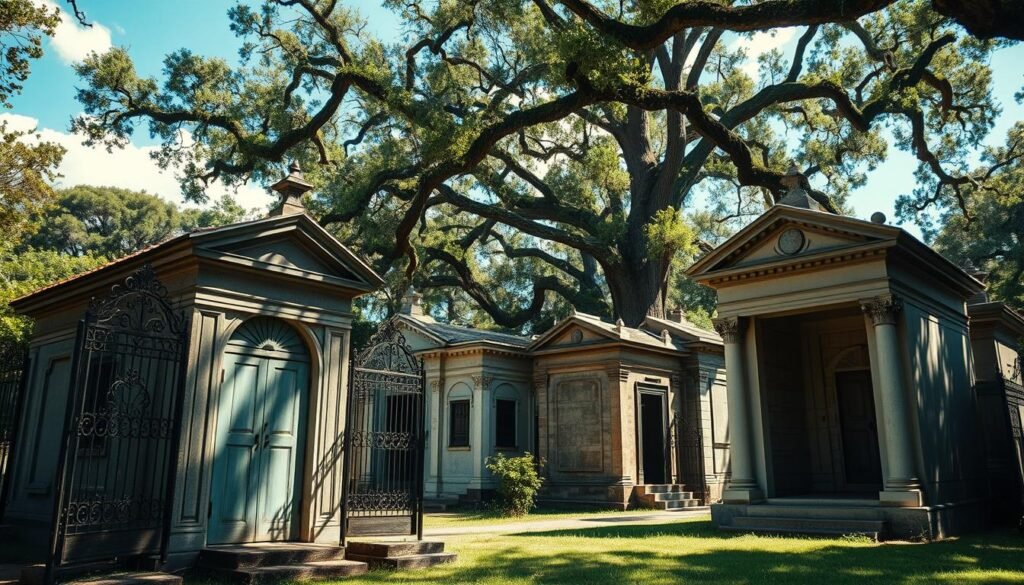
Its Role in New Orleans History
Lafayette Cemetery No. 1 has played a significant role in New Orleans’ history, serving as a burial ground for many of the city’s prominent citizens. Established in 1833, it’s one of the oldest cemeteries in the city. The cemetery’s layout and architecture reflect the city’s history and cultural influences, making it a fascinating place to explore.
“Lafayette Cemetery No. 1 is a testament to the city’s resilience and cultural richness,” as noted by local historians. The cemetery’s historic significance is not just in its age but also in the stories it tells through its monuments and tombs.
Events and Tours Available
Visitors to Lafayette Cemetery No. 1 can enjoy guided tours that delve into the cemetery’s history, notable residents, and architectural styles. These tours offer a unique insight into the cemetery’s significance and the stories behind its historic tombs.
- Guided walking tours available daily
- Special events during the Halloween season
- Self-guided tour maps available at the cemetery entrance
Whether you’re a history buff, an architecture enthusiast, or simply looking for a unique experience, Lafayette Cemetery No. 1 is a place that will captivate and inspire you.
The Haunted Reputation of New Orleans Cemeteries
As a local, I’ve grown up hearing tales of the paranormal activity surrounding New Orleans’ famous cemeteries. The city’s historic graveyards are often associated with ghost stories and legends, adding to the mystique and allure of these sacred spaces.
The atmosphere in these cemeteries can be quite eerie, especially during twilight hours or on certain dates like Halloween. Many visitors have reported strange occurrences, from unexplained noises to apparitions, fueling the reputation of these cemeteries as haunted hotspots.
Ghost Stories and Legends
New Orleans’ cemeteries are home to a multitude of ghost stories and legends. One of the most famous tales is that of the LaLaurie Ghost, associated with St. Louis Cemetery No. 1, where Madame Delphine LaLaurie, a wealthy socialite and slave owner, is buried. Her cruel deeds are said to have unleashed a malevolent spirit.
Another legend is that of the Congo Square Vampire, said to roam the cemeteries in search of its next victim. Such stories have been passed down through generations, captivating the imagination of both locals and tourists.
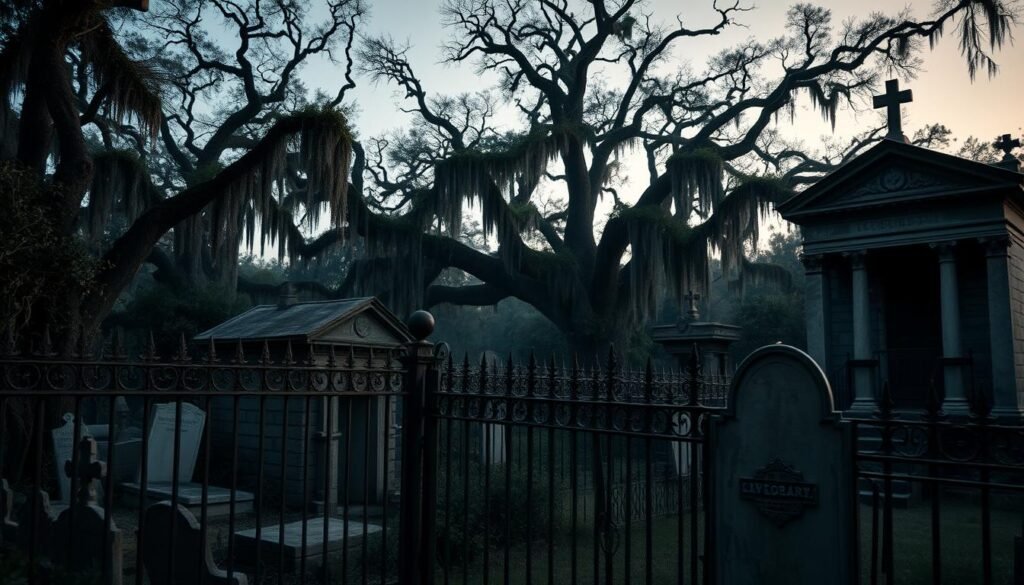
Haunted Tours and Experiences
For those brave enough to explore the spooky side of New Orleans, various haunted tours and experiences are available. These tours often include visits to the city’s most infamous cemeteries, providing a thrilling way to delve into the city’s paranormal history.
| Tour Type | Description | Duration |
|---|---|---|
| Ghostly Walking Tour | Explore haunted cemeteries and historic sites on foot | 2 hours |
| Cemetery Bus Tour | Visit multiple famous cemeteries with a guided commentary | 3 hours |
| Paranormal Investigation Tour | Join experts on a ghost hunt in New Orleans’ most haunted sites | 4 hours |
These tours not only offer a glimpse into New Orleans’ haunted past but also provide a unique perspective on the city’s cultural heritage. Whether you’re a believer in the paranormal or just looking for a unique experience, these tours are sure to leave a lasting impression.
Metairie Cemetery: A Blend of Art and History
Metairie Cemetery stands as a testament to New Orleans’ rich history and artistic expression. This historic cemetery is not just a final resting place for many notable figures but also a showcase of stunning monuments and mausoleums that reflect the city’s complex cultural heritage.
As you stroll through the cemetery’s grounds, you’ll be struck by the grandeur of its architecture. The cemetery is home to numerous impressive structures, each telling a story of the past.
Famous Monuments and Mausoleums
Some of the most striking features of Metairie Cemetery are its majestic monuments and mausoleums. These structures are not only beautiful works of art but also historical markers that provide insight into the lives of those buried here.
- The Battlefield Monument commemorates the soldiers who fought in the Civil War.
- The Pyramid Tomb is an iconic structure that dominates the cemetery’s landscape.
- The Mausoleum of the Confederate Veterans is a poignant tribute to those who served.
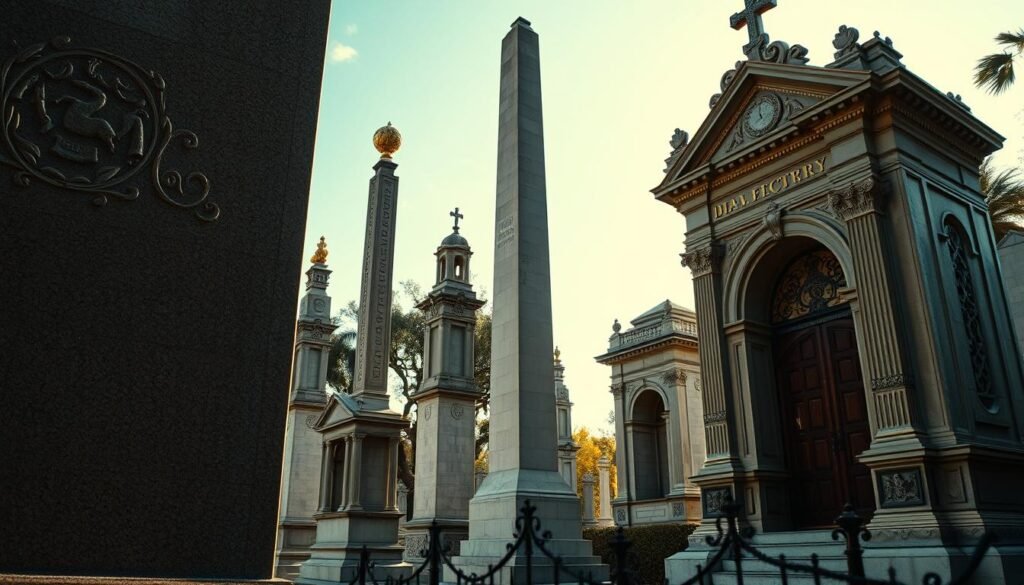
The Cemetery’s Notable Figures
Metairie Cemetery is the final resting place for many notable figures in New Orleans history. Some of the prominent individuals buried here include:
- Confederate General P.G.T. Beauregard
- Business magnate and philanthropist, Ernest J. Bell
- Noted jazz musician and bandleader, Paul “Papa” Barbarin
These individuals, among many others, have left an indelible mark on the city’s history and culture.
Oak Alley Cemetery: A Scenic Retreat
Tucked away in the historic Oak Alley Plantation, Oak Alley Cemetery is a serene destination that beckons visitors to explore its storied past. As you step through its gates, you’re enveloped in the tranquility of the surroundings, with ancient oak trees providing a canopy of shade and the Mississippi River flowing gently in the distance.
The Surrounding Natural Beauty
The cemetery’s landscape is a testament to the natural beauty of Louisiana. The historic above-ground tombs, adorned with intricate carvings and weathered by time, stand as sentinels against the backdrop of lush greenery. The Oak Alley Plantation, with its 28 majestic oak trees, forms a picturesque frame around the cemetery, creating a scene that’s as hauntingly beautiful as it is historically significant.
As you wander through the cemetery, the gentle rustle of leaves and the soft chirping of birds provide a soothing melody, making it a perfect spot for reflection and contemplation. The serene atmosphere is a balm to the soul, offering a peaceful respite from the hustle and bustle of daily life.
Visiting Guidelines and Events
Visiting Oak Alley Cemetery is a straightforward and enriching experience. The cemetery is open to the public, and visitors are encouraged to explore its grounds. For those interested in a more in-depth experience, guided tours are available, offering insights into the history and significance of the tombs and the people buried there.
Throughout the year, Oak Alley Cemetery hosts various events that celebrate its history and cultural significance. These events range from historical reenactments to cultural festivals, providing a unique opportunity to experience the rich heritage of the region. Visitors are advised to check the plantation’s event calendar to catch one of these events during their visit.
In conclusion, Oak Alley Cemetery is one of the must-visit cemeteries in the big easy, offering a blend of natural beauty, historical significance, and cultural richness. Whether you’re a history buff, a nature lover, or simply someone looking for a peaceful retreat, Oak Alley Cemetery is sure to leave a lasting impression.
Preservation Efforts for Historic Cemeteries
As a city rich in history, New Orleans’ cemeteries are not just final resting places but also cultural landmarks that need our care and attention. These historic sites, often referred to as the “famous resting places in New Orleans,” are a significant part of the city’s heritage.
The Challenges of Preservation
Preserving these cemeteries is a complex task due to various challenges. Environmental factors such as humidity, rainfall, and the Mississippi River’s proximity contribute to the deterioration of tombstones and vaults. Additionally, vandalism and neglect pose significant threats to these historic sites.
Environmental Challenges: The subtropical climate of New Orleans accelerates the decay of materials used in the construction of tombs and mausoleums. Salt air and high moisture levels can cause crumbling and erosion.
Restoration Efforts: To combat these issues, restoration projects are undertaken to repair and stabilize the structures. This includes repointing brickwork, restoring ornamental features, and ensuring that the drainage systems are functioning properly.
Community Involvement and Support
The preservation of New Orleans’ cemeteries is not just a task for preservation societies or government agencies; it requires active community involvement. Local residents, along with visitors who appreciate the historical significance of these sites, play a crucial role in their upkeep.
- Volunteer clean-up events are organized regularly, bringing together community members to clean and restore the cemeteries.
- Educational programs are implemented to raise awareness about the importance of these cemeteries and the challenges they face.
- Fundraising events are held to support restoration projects and ensure the long-term preservation of these historic graveyards.
By working together, we can ensure that New Orleans’ haunted graveyards in Louisiana continue to be a vibrant part of the city’s cultural landscape, attracting visitors and locals alike to appreciate their beauty and history.
Conclusion: Why You Should Explore New Orleans’ Cemeteries
Exploring New Orleans’ famous cemeteries is a journey into the heart of the city’s culture and heritage. By visiting these historic sites, you’ll gain a deeper understanding of the people and events that have shaped the city.
Cultural Significance
The must-visit cemeteries in the Big Easy, such as St. Louis Cemetery No. 3, Greenwood Cemetery, St. Roch Cemetery, and Metairie Cemetery, offer a unique insight into the city’s history, culture, and spirituality. These cemeteries are not just final resting places, but also showcase the city’s rich cultural heritage.
Planning Your Visit
To make the most of your experience, consider taking a guided tour or self-guided exploration. You can find more information on planning your cemetery tour on resources like Nola Tour Guy, which provides valuable insights and tips.
By exploring New Orleans’ famous cemeteries, you’ll develop a deeper appreciation for the city’s history, culture, and people. So, take a stroll through these historic sites and experience the city’s unique charm.
FAQ
What makes New Orleans cemeteries so unique?
New Orleans cemeteries are known for their above-ground tombs, a necessity due to the city’s low elevation and high water table. This unique burial practice, influenced by the city’s cultural melting pot, has become an iconic feature of the city’s landscape.
Can I visit St. Louis Cemetery No. 1?
Yes, St. Louis Cemetery No. 1 is open to visitors, but due to its age and fragile condition, visitors are required to be part of a guided tour to ensure the cemetery’s preservation.
Are New Orleans cemeteries haunted?
Many New Orleans cemeteries are associated with ghost stories and legends, adding to the city’s mystique and allure. Visitors can explore these spooky tales through haunted tours and experiences.
What is the significance of Marie Laveau’s tomb in St. Louis Cemetery No. 1?
Marie Laveau, the Voodoo Queen of New Orleans, is buried in St. Louis Cemetery No. 1. Her tomb is a popular site for visitors, who come to pay their respects and leave offerings, reflecting her enduring legacy in the city’s culture.
How can I plan a cemetery tour in New Orleans?
To plan a cemetery tour, start by choosing which cemeteries to visit, such as St. Louis Cemetery No. 1, Lafayette Cemetery No. 1, or Metairie Cemetery. Consider guided tours, which can provide valuable insights into the history and legends surrounding the cemeteries.
What are some of the notable figures buried in Metairie Cemetery?
Metairie Cemetery is the final resting place of many notable figures, including Confederate veterans and wealthy businessmen. The cemetery’s monuments and mausoleums reflect the complex history of the city and its people.
How are New Orleans’ historic cemeteries preserved?
Preserving New Orleans’ historic cemeteries requires the efforts of local communities, preservation societies, and government agencies. These groups work together to address the challenges faced by the cemeteries, from environmental factors to vandalism.
Can I visit Oak Alley Cemetery?
Yes, Oak Alley Cemetery is open to visitors. The cemetery, surrounded by the natural beauty of the Oak Alley Plantation, offers a serene and picturesque destination for those interested in history and the region’s cultural heritage.
What is the best time to visit New Orleans cemeteries?
The best time to visit New Orleans cemeteries is during the cooler months, from October to March, when the weather is more comfortable for walking tours. Visitors should also consider visiting during the day to avoid any potential safety issues.
Are there any special events or tours available at Lafayette Cemetery No. 1?
Yes, Lafayette Cemetery No. 1 hosts various events and tours throughout the year, allowing visitors to experience the beauty and tranquility of this historic site. These events provide a unique opportunity to explore the cemetery’s history and significance.
